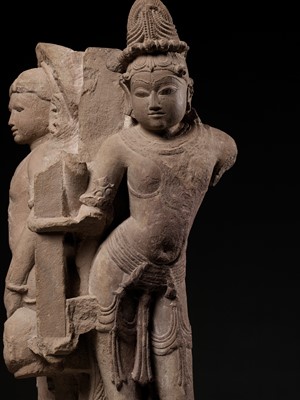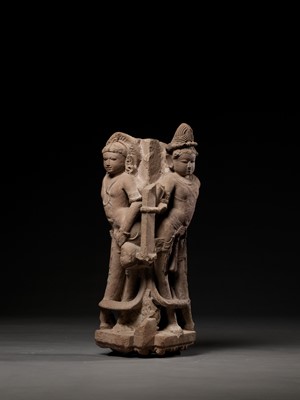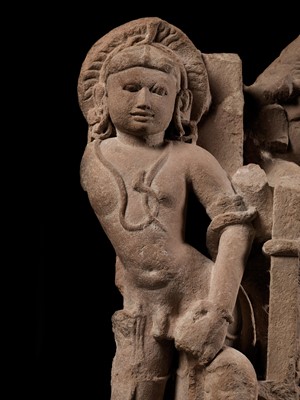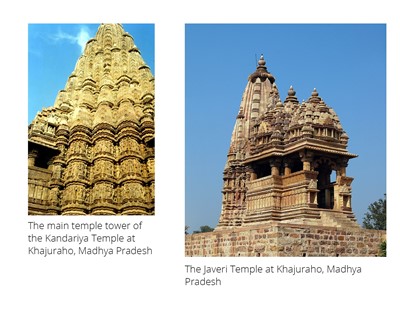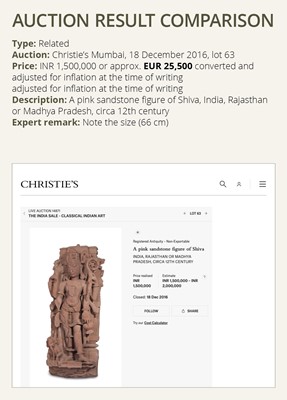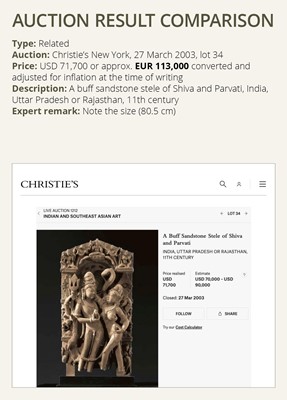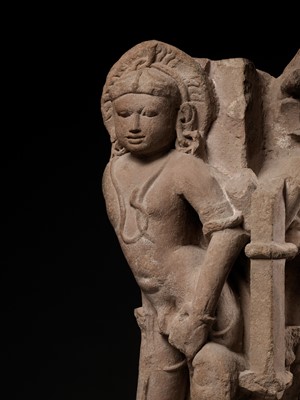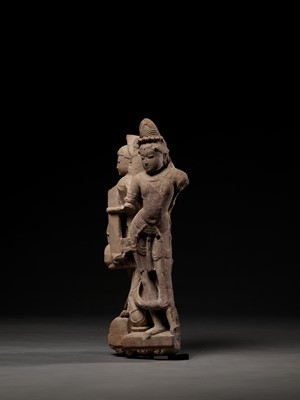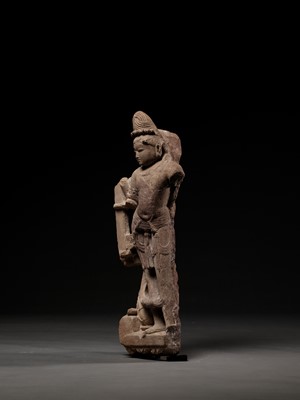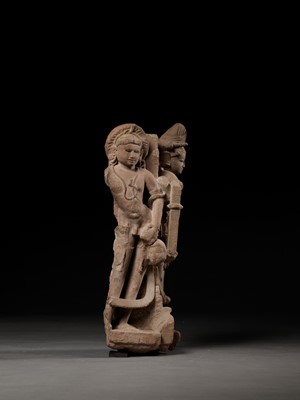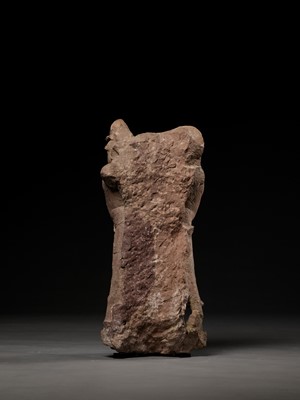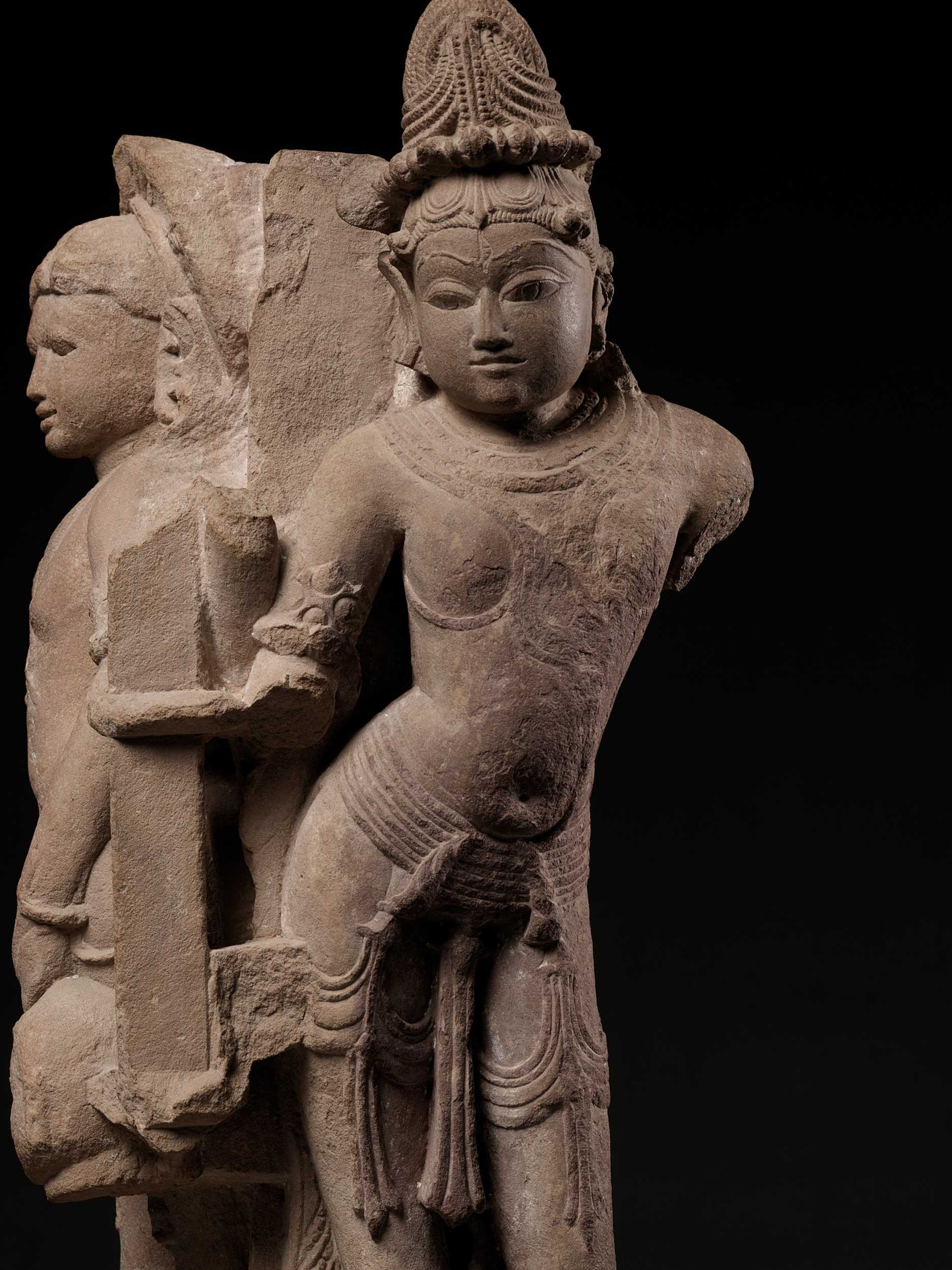30th Sep, 2022 10:00
DAY 2 - TWO-DAY AUCTION - Fine Chinese Art / 中國藝術集珍 / Buddhism & Hinduism
700
† A PINK SANDSTONE ARCHITECTURAL CORNER ELEMENT WITH TWO MANIFESTATIONS OF SHIVA, CHANDELLA PERIOD
Sold for €22,880
including Buyer's Premium
Northern India, Rajasthan, mid-11th century. The corner piece carved with two figures, each a different form of Shiva. The figure on the left resembling Bhairava, holding a head of Brahma in his left hand, a twisted serpent writhing around his neck, the headdress formed from sinuous snakes, the face with an unusually serene expression. The figure on the right resembling Shiva in his pure Mahadeva (great god) form, elegantly dressed, the hair arranged in a chignon secured by a crown, with pearls and flowers around his forehead.
Provenance: From a notable collector in London, United Kingdom.
Condition: Excellent condition, commensurate with age. Extensive wear, nicks, losses, minor signs of weathering and erosion, few structural cracks.
Dimensions: Height 72.5 cm
Each figure stands in tribhanga, the relaxed triple-angled pose adopted by gods as they attend to their devotees. They have round faces, the god resembling Bhairava frowns slightly, but his Mahadeva-like companion looks benignly, confidently downwards. Both faces are stylized, but not in the exaggerated way that one sees increasingly towards the end of the 11th century. The sculpture is fashioned in pink sandstone which suggests that it comes from the western part of the Chandella kingdom, probably the southern region of Rajasthan.
The fine, smooth texture of this specific pink sandstone made it the ideal raw material, both for architectural purposes and detailed sculptural work.
The present sculpture is an architectural cornerstone element that would have been placed high on the wall of a Shaivite temple, so the devotees looked up at it. Consequently, the two gods look down as they encounter the visitor. The narrow ledge on which they stand is emphasized by the position of their feet, only just able to rest securely. Likewise, as they are sculpted in high relief, they seem to press their hips against the backing block. This of course was shaped to form part of the temple wall.
Various stylistic elements indicate that the sculpture dates from the 11th century. The long straight legs and slender body of each figure are indicative of this date and well illustrate the elegance of the mature Chandella style. In the 10th century, both male and female figures tend to appear shorter and plumper.
In northern India during the 8th to 13th centuries, numerous princely states coexisted. This was a period marked by warfare, rivalries and political alliances, taking place against a backdrop of an elegant courtly culture. Regardless of their status amongst their peers, the various rulers aimed to emulate the atmosphere of the 4th - 6th century Gupta Empire, which had been a time of literary and artistic achievement.
The Chandella dynasty became a great power in northern India in the 10th century. Thereafter successive rulers built magnificent temples at Khajuraho and elsewhere in their realm, to commemorate their military victories. As their influence expanded, their exquisite architectural style became admired across much of northern India, as indeed, it is now around the world. Chandella kings commissioned some of the finest temples in northern India. The best known of these today are in Khajuraho, Madhya Pradesh, now a village but once the Chandella capital. Other temples, no longer standing, were located throughout their realm.
Expert’s note: A detailed commentary on the present lot, showing many further comparisons to examples in both public and private collections, is available upon request. To receive a PDF copy of this academic dossier, please refer to the department.
Auction result comparison:
Type: Related
Auction: Christie’s New York, 27 March 2003, lot 34
Price: USD 71,700 or approx. EUR 113,000 converted and adjusted for inflation at the time of writing
Description: A buff sandstone stele of Shiva and Parvati, India, Uttar Pradesh or Rajasthan, 11th century
Expert remark: Note the size (80.5 cm)
Auction result comparison:
Type: Related
Auction: Christie’s Mumbai, 18 December 2016, lot 63
Price: INR 1,500,000 or approx. EUR 25,500 converted and adjusted for inflation at the time of writing
Description: A pink sandstone figure of Shiva, India, Rajasthan or Madhya Pradesh, circa 12th century
Expert remark: Note the size (66 cm)
Northern India, Rajasthan, mid-11th century. The corner piece carved with two figures, each a different form of Shiva. The figure on the left resembling Bhairava, holding a head of Brahma in his left hand, a twisted serpent writhing around his neck, the headdress formed from sinuous snakes, the face with an unusually serene expression. The figure on the right resembling Shiva in his pure Mahadeva (great god) form, elegantly dressed, the hair arranged in a chignon secured by a crown, with pearls and flowers around his forehead.
Provenance: From a notable collector in London, United Kingdom.
Condition: Excellent condition, commensurate with age. Extensive wear, nicks, losses, minor signs of weathering and erosion, few structural cracks.
Dimensions: Height 72.5 cm
Each figure stands in tribhanga, the relaxed triple-angled pose adopted by gods as they attend to their devotees. They have round faces, the god resembling Bhairava frowns slightly, but his Mahadeva-like companion looks benignly, confidently downwards. Both faces are stylized, but not in the exaggerated way that one sees increasingly towards the end of the 11th century. The sculpture is fashioned in pink sandstone which suggests that it comes from the western part of the Chandella kingdom, probably the southern region of Rajasthan.
The fine, smooth texture of this specific pink sandstone made it the ideal raw material, both for architectural purposes and detailed sculptural work.
The present sculpture is an architectural cornerstone element that would have been placed high on the wall of a Shaivite temple, so the devotees looked up at it. Consequently, the two gods look down as they encounter the visitor. The narrow ledge on which they stand is emphasized by the position of their feet, only just able to rest securely. Likewise, as they are sculpted in high relief, they seem to press their hips against the backing block. This of course was shaped to form part of the temple wall.
Various stylistic elements indicate that the sculpture dates from the 11th century. The long straight legs and slender body of each figure are indicative of this date and well illustrate the elegance of the mature Chandella style. In the 10th century, both male and female figures tend to appear shorter and plumper.
In northern India during the 8th to 13th centuries, numerous princely states coexisted. This was a period marked by warfare, rivalries and political alliances, taking place against a backdrop of an elegant courtly culture. Regardless of their status amongst their peers, the various rulers aimed to emulate the atmosphere of the 4th - 6th century Gupta Empire, which had been a time of literary and artistic achievement.
The Chandella dynasty became a great power in northern India in the 10th century. Thereafter successive rulers built magnificent temples at Khajuraho and elsewhere in their realm, to commemorate their military victories. As their influence expanded, their exquisite architectural style became admired across much of northern India, as indeed, it is now around the world. Chandella kings commissioned some of the finest temples in northern India. The best known of these today are in Khajuraho, Madhya Pradesh, now a village but once the Chandella capital. Other temples, no longer standing, were located throughout their realm.
Expert’s note: A detailed commentary on the present lot, showing many further comparisons to examples in both public and private collections, is available upon request. To receive a PDF copy of this academic dossier, please refer to the department.
Auction result comparison:
Type: Related
Auction: Christie’s New York, 27 March 2003, lot 34
Price: USD 71,700 or approx. EUR 113,000 converted and adjusted for inflation at the time of writing
Description: A buff sandstone stele of Shiva and Parvati, India, Uttar Pradesh or Rajasthan, 11th century
Expert remark: Note the size (80.5 cm)
Auction result comparison:
Type: Related
Auction: Christie’s Mumbai, 18 December 2016, lot 63
Price: INR 1,500,000 or approx. EUR 25,500 converted and adjusted for inflation at the time of writing
Description: A pink sandstone figure of Shiva, India, Rajasthan or Madhya Pradesh, circa 12th century
Expert remark: Note the size (66 cm)
Zacke Live Online Bidding
Our online bidding platform makes it easier than ever to bid in our auctions! When you bid through our website, you can take advantage of our premium buyer's terms without incurring any additional online bidding surcharges.
To bid live online, you'll need to create an online account. Once your account is created and your identity is verified, you can register to bid in an auction up to 12 hours before the auction begins.
Intended Spend and Bid Limits
When you register to bid in an online auction, you will need to share your intended maximum spending budget for the auction. We will then review your intended spend and set a bid limit for you. Once you have pre-registered for a live online auction, you can see your intended spend and bid limit by going to 'Account Settings' and clicking on 'Live Bidding Registrations'.
Your bid limit will be the maximum amount you can bid during the auction. Your bid limit is for the hammer price and is not affected by the buyer’s premium and VAT. For example, if you have a bid limit of €1,000 and place two winning bids for €300 and €200, then you will only be able to bid €500 for the rest of the auction. If you try to place a bid that is higher than €500, you will not be able to do so.
Online Absentee and Telephone Bids
You can now leave absentee and telephone bids on our website!
Absentee Bidding
Once you've created an account and your identity is verified, you can leave your absentee bid directly on the lot page. We will contact you when your bids have been confirmed.
Telephone Bidding
Once you've created an account and your identity is verified, you can leave telephone bids online. We will contact you when your bids have been confirmed.
Classic Absentee and Telephone Bidding Form
You can still submit absentee and telephone bids by email or fax if you prefer. Simply fill out the Absentee Bidding/Telephone bidding form and return it to us by email at office@zacke.at or by fax at +43 (1) 532 04 52 20. You can download the PDF from our Upcoming Auctions page.
How-To Guides
How to Create Your Personal Zacke Account
How to Register to Bid on Zacke Live
How to Leave Absentee Bids Online
How to Leave Telephone Bids Online
中文版本的操作指南
创建新账号
注册Zacke Live在线直播竞拍(免平台费)
缺席投标和电话投标
Third-Party Bidding
We partner with best-in-class third-party partners to make it easy for you to bid online in the channel of your choice. Please note that if you bid with one of our third-party online partners, then there will be a live bidding surcharge on top of your final purchase price. You can find all of our fees here. Here's a full list of our third-party partners:
- 51 Bid Live
- EpaiLive
- ArtFoxLive
- Invaluable
- LiveAuctioneers
- the-saleroom
- lot-tissimo
- Drouot
Please note that we place different auctions on different platforms. For example, in general, we only place Chinese art auctions on 51 Bid Live.
Bidding in Person
You must register to bid in person and will be assigned a paddle at the auction. Please contact us at office@zacke.at or +43 (1) 532 04 52 for the latest local health and safety guidelines.
